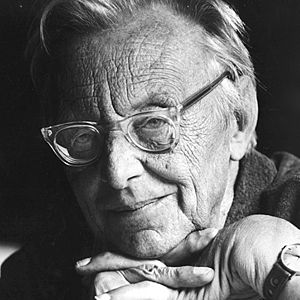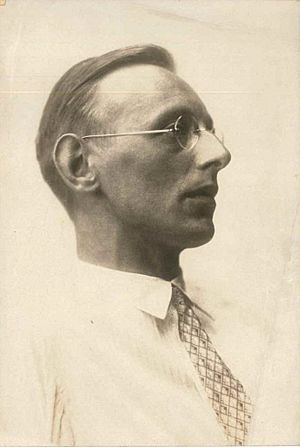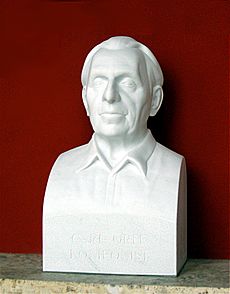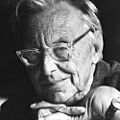Carl Orff facts for kids
Quick facts for kids
Carl Orff
|
|
|---|---|

Carl Orff, c. 1970
|
|
| Born | 10 July 1895 Munich, Kingdom of Bavaria, German Empire
|
| Died | 29 March 1982 (aged 86) Munich, West Germany
|
|
Works
|
List of compositions |
Carl Orff (born July 10, 1895 – died March 29, 1982) was a famous German composer and music teacher. He is most known for his powerful musical work called Carmina Burana, which he wrote in 1937.
Carl Orff also created a special way of teaching music to children, called the Orff Schulwerk. This method has been very important and helpful for music education around the world.
Life of Carl Orff
Growing Up and Early Music
Carl Orff was born in Munich, Germany, on July 10, 1895. His full name was Karl Heinrich Maria Orff. His family was from Bavaria, a region in Germany.
Even though his family had a military background, Carl Orff remembered that there was "certainly more music making than drilling" in his home. He started playing the piano at age five. Later, he learned to play the cello and organ.
He even wrote some songs and music for puppet shows when he was young. He also had some small stories published in a children's magazine.
Becoming a Musician
Carl Orff studied music at the Munich Academy of Music from 1912 to 1914. He found the academy a bit old-fashioned.
During this time, he was very interested in the music of French composer Claude Debussy. These influences could be heard in his early works.
World War I and Its Impact
In August 1917, Carl Orff had to join the German Army during World War I. This was a very difficult time for him.
He was badly injured when a trench collapsed. He suffered memory loss and had trouble speaking and moving his left side. His daughter later said she believed this experience made him think in new, more revolutionary ways.
New Ideas in Music
After recovering, Orff worked at opera houses. He then returned to Munich to continue his music studies. Around 1920, he became interested in the poems of Franz Werfel, which inspired many of his songs.
In the mid-1920s, Orff started to develop his idea of "elemental music." This idea was about combining different art forms like music, dance, poetry, and theater. He believed all these arts were connected, like the ancient Greek Muses.
He was also influenced by the Russian-French composer Igor Stravinsky. Orff especially liked Stravinsky's work Les noces (The Wedding), which used earthy, folk-like sounds.
The Günther-Schule and Schulwerk
In 1924, Carl Orff and Dorothee Günther started the Günther-Schule in Munich. This school taught gymnastics, music, and dance. Here, Orff developed his ideas for music education. He worked directly with children and beginners.
In 1930, he published a guide called Schulwerk. This book shared his teaching methods. Orff stayed involved with the Schulwerk throughout his life.
He also worked on adapting old musical works for modern theater. For example, he created a shorter German version of Claudio Monteverdi's opera L'Orfeo from 1607.
Life During the Nazi Era
Carl Orff's connection with the Nazi Party has been discussed a lot. It's important to know that he never joined the Nazi Party. He also did not hold any leadership positions with them.
Many of Orff's friends and colleagues had to leave Germany during this time. But Orff stayed in touch with some of them after the war. He even remained lifelong friends with some, like the singer Karel Salmon and the musicologist Erich Katz, who were Jewish and had to flee.
Carmina Burana Becomes Famous
Orff's most famous work, Carmina Burana, was first performed in Frankfurt on June 8, 1937. It quickly became very popular in Germany.
The success of Carmina Burana brought Orff significant money. However, some people in the Nazi regime criticized the music for its unusual rhythms.
Music for Shakespeare
The Nazis banned the music of Jewish composer Felix Mendelssohn. Because of this, Carl Orff was asked to write new music for William Shakespeare's play A Midsummer Night's Dream.
Orff's version was first performed in Frankfurt in 1939. He had actually thought about writing music for this play much earlier, in 1917 and 1927. He revised his Ein Sommernachtstraum score three more times over the years.
Friendship with Kurt Huber
Orff was friends with Kurt Huber, a university professor. They worked together on Bavarian folk music. Huber later became a member of the student resistance group called the White Rose.
In 1943, Huber was arrested and executed by the Nazis. Orff was very upset when he heard about his friend's arrest. After the war, Orff helped Huber's family. He even dedicated one of his works, Die Bernauerin, to Huber's memory. This work is about a woman who is wrongly executed.
After the War
After World War II, Carl Orff was evaluated by American officials to see if he had supported the Nazis. He was allowed to continue his work as a composer.
The officials noted that Orff's income had increased during the Nazi era. However, they also knew that he had not been a strong supporter of the Nazi government.
Personal Life
Carl Orff kept his personal life very private. He was married four times. His only child, a daughter named Godela, was born in 1921 from his first marriage.
He was raised Catholic but did not follow religious rules strictly as an adult. He was a spiritual person, but he didn't go to church. He wanted to be buried at the Andechs Abbey church, which he could see from his home.
Orff's parents supported his musical dreams, even though they had a military background. His mother, Paula Orff, especially encouraged his creativity. Carl Orff's relationship with his daughter, Godela, was sometimes difficult, but they became close again later in his life.
Death
Carl Orff died from cancer in Munich on March 29, 1982. He was 86 years old. He is buried at the Andechs monastery, as he wished. His tombstone has a Latin phrase: Summus Finis, which means "the Ultimate End." This phrase comes from his last musical work.
Carl Orff's Works
The Famous Carmina Burana
Carl Orff is most famous for Carmina Burana (1936). It's a "scenic cantata", which is a type of musical story. It's the first part of a group of three works called Trionfi, or "Triumphs."
Carmina Burana shows Orff's interest in medieval German poetry. The work uses poems from the 13th century that were found in a manuscript called the Carmina Burana codex. These poems were written in Latin and an old form of German.
The most well-known part of Carmina Burana is the opening and closing chorus, "O Fortuna". This powerful music is often used in movies and TV shows to show strong, dramatic forces.
Later Works
Most of Orff's later works were based on ancient Greek stories or texts. These include Antigonae (1949), Oedipus der Tyrann (Oedipus the Tyrant, 1959), and Prometheus desmotes (Prometheus Bound, 1968).
These works use a very unusual mix of instruments. They often feature large percussion sections, including non-Western instruments, and many pianos. They don't use traditional string sections like violins or cellos.
Orff's final stage work was De temporum fine comoedia (Play on the End of Times), which premiered in 1973. In this very personal work, Orff explored his ideas about the end of time, drawing from different religious traditions.
Music for Children: Schulwerk
In teaching, Carl Orff is best remembered for his Schulwerk ("School Work"). This was originally a collection of pieces written for the Güntherschule.
The Schulwerk ideas were developed with his student, Gunild Keetman. It's a very creative way to teach music to children. It combines movement, singing, playing instruments, and making up music on the spot.
Some of the music from Schulwerk, like Gassenhauer, has even been used in movies!
List of compositions
Carl Orff's music is published by Schott Music.
- Stage Works
- Gisei: Das Opfer (Gisei: The Sacrifice), 1913
- Lamenti (a group of works based on older music, including Orpheus), first performed as a cycle in 1958
- Trionfi. A set of three stage works:
- Carmina Burana (1934–1936)
- Catulli Carmina (1941–1943)
- Trionfo di Afrodite (1947–1951)
- Märchenstücke (Fairy tales):
- Der Mond (The Moon), based on a Brothers Grimm story (1936–1938)
- Die Kluge (The Wise Woman), also based on a Brothers Grimm story (1941–1942)
- Ein Sommernachtstraum (A Midsummer Night's Dream), music for Shakespeare's play (first completed in 1938–1939, revised several times)
- Bairisches Welttheater (Bavarian world theatre):
- Die Bernauerin (1944–1946)
- Astutuli (1946–1948)
- Comoedia de Christi Resurrectione (Easter Play, 1955)
- Ludus de nato Infante mirificus (Nativity Play, 1960)
- Theatrum Mundi (World Theatre):
- Antigonae, based on Sophocles's play (1940–1949)
- Oedipus der Tyrann (Oedipus the Tyrant), based on Sophocles's play (1951–58)
- Prometheus, based on the Greek play (1960–67)
- De temporum fine comoedia (Play on the End of Times), his last stage work (1970–71)
- Vocal Works
- Zarathustra, for baritone, choruses, and instruments (1911–1912)
- Werkbuch I and Werkbuch II, cantatas for chorus and instruments (1930s)
- Dithyrambi, for chorus and instruments (1955–1956)
- Rota, for children's chorus, mixed chorus, and instruments (1972)
- Many early songs for solo voice with piano (1910s)
- Instrumental Works
- Tanzende Faune: Ein Orchesterspiel (Dancing Fauns: An Orchestral Play), for orchestra (1914)
- Entrata, for large orchestra (1928)
- Kleines Konzert nach Lautensätzen aus dem 16. Jh. (Small Concert after Lute Pieces from the 16th Century), for ensemble (1927)
- String Quartets (early 1900s)
- Pedagogical Works
- Orff Schulwerk
- Musik für Kinder (Music for Children), with Gunild Keetman (1930–35, revised 1950–54)
- Tanzstück (1933)
- Gassenhauer
- Orff Schulwerk
Images for kids
See also
 In Spanish: Carl Orff para niños
In Spanish: Carl Orff para niños








